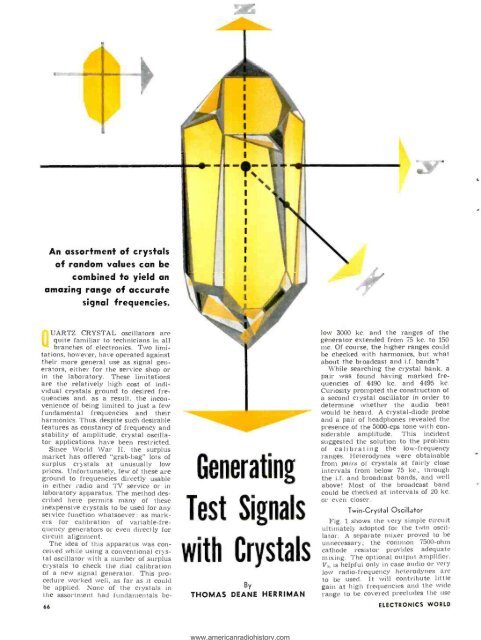Electronics-World-1959-05
You also want an ePaper? Increase the reach of your titles
YUMPU automatically turns print PDFs into web optimized ePapers that Google loves.
www.americanradiohistory.com<br />
M<br />
An assortment of crystals<br />
of random values can be<br />
combined to yield an<br />
amazing range of accurate<br />
signal frequencies.<br />
QUARTZ CRYSTAL oscillators are<br />
quite familiar to technicians in all<br />
branches of electronics. Two limitations,<br />
however, have operated against<br />
their more general use as signal generators,<br />
either for the service shop or<br />
in the laboratory. These limitations<br />
are the relatively high cost of individual<br />
crystals ground to desired frequencies<br />
and, as a result, the inconvenience<br />
of being limited to just a few<br />
fundamental frequencies and their<br />
harmonics. Thus, despite such desirable<br />
features as constancy of frequency and<br />
stability of amplitude, crystal oscillator<br />
applications have been restricted.<br />
Since <strong>World</strong> War II, the surplus<br />
market has offered "grab-bag" lots of<br />
surplus crystals at unusually low<br />
prices. Unfortunately, few of these are<br />
ground to frequencies directly usable<br />
in either radio and TV service or in<br />
laboratory apparatus. The method described<br />
here permits many of these<br />
inexpensive crystals to be used for any<br />
service function whatsoever: as markers<br />
for calibration of variable -frequency<br />
generators or even directly for<br />
circuit alignment.<br />
The idea of this apparatus was conceived<br />
while using a conventional crystal<br />
oscillator with a number of surplus<br />
crystals to check the dial calibration<br />
of a new signal generator. This procedure<br />
worked well, as far as it could<br />
be applied. None of the crystals in<br />
the assortment had fundamentals be-<br />
Generating<br />
Test Signals<br />
with Crystals<br />
THOMAS DEANE HERRIMAN<br />
low 3000 kc. and the ranges of the<br />
generator extended from 75 kc. to 150<br />
mc. Of course, the higher ranges could<br />
be checked with harmonics, but what<br />
about the broadcast and i.f. bands?<br />
While searching the crystal bank, a<br />
pair was found having marked frequencies<br />
of 4490 kc. and 4495 kc.<br />
Curiosity prompted the construction of<br />
a second crystal oscillator in order to<br />
determine whether the audio beat<br />
would be heard. A crystal -diode probe<br />
and a pair of headphones revealed the<br />
presence of the 5000 -cps tone with considerable<br />
amplitude. This incident<br />
suggested the solution to the problem<br />
of calibrating the low- frequency<br />
ranges. Heterodynes were obtainable<br />
from pairs of crystals at fairly close<br />
intervals from below 75 kc., through<br />
the i.f. and broadcast bands, and well<br />
above! Most of the broadcast band<br />
could be checked at intervals of 20 kc.<br />
or even closer.<br />
Twin -Crystal Oscillator<br />
Fig. 1 shows the very simple circuit<br />
ultimately adopted for the twin oscillator.<br />
A separate mixer proved to be<br />
unnecessary; the common 7500 -ohm<br />
cathode resistor provides adequate<br />
mixing. The optional output amplifier,<br />
V,, is helpful only in case audio or very<br />
low radio- frequency heterodynes are<br />
to be used. It will contribute little<br />
gain at high frequencies and the wide<br />
range to be covered precludes the use<br />
66 ELECTRONICS WORLD



